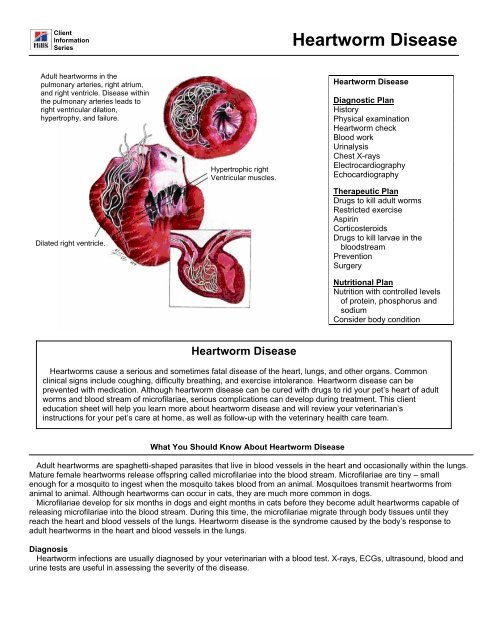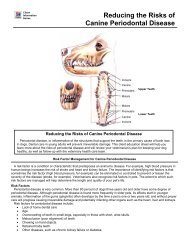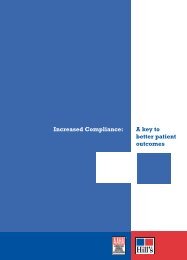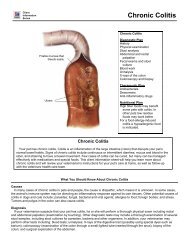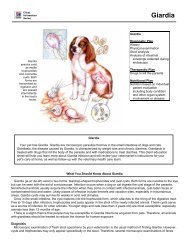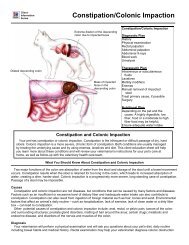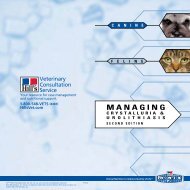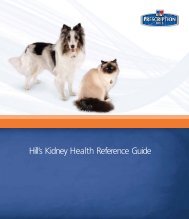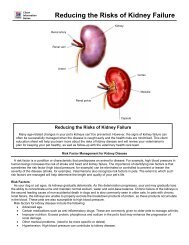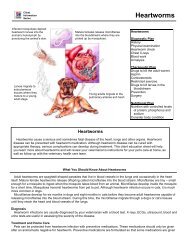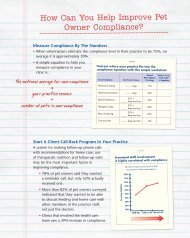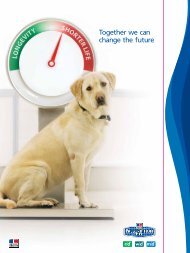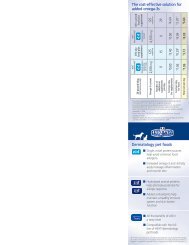Heartworm Disease - HillsVet
Heartworm Disease - HillsVet
Heartworm Disease - HillsVet
You also want an ePaper? Increase the reach of your titles
YUMPU automatically turns print PDFs into web optimized ePapers that Google loves.
Client<br />
Information<br />
Series<br />
<strong>Heartworm</strong> <strong>Disease</strong><br />
Adult heartworms in the<br />
pulmonary arteries, right atrium,<br />
and right ventricle. <strong>Disease</strong> within<br />
the pulmonary arteries leads to<br />
right ventricular dilation,<br />
hypertrophy, and failure.<br />
Dilated right ventricle.<br />
Hypertrophic right<br />
Ventricular muscles.<br />
<strong>Heartworm</strong> <strong>Disease</strong><br />
Diagnostic Plan<br />
History<br />
Physical examination<br />
<strong>Heartworm</strong> check<br />
Blood work<br />
Urinalysis<br />
Chest X-rays<br />
Electrocardiography<br />
Echocardiography<br />
Therapeutic Plan<br />
Drugs to kill adult worms<br />
Restricted exercise<br />
Aspirin<br />
Corticosteroids<br />
Drugs to kill larvae in the<br />
bloodstream<br />
Prevention<br />
Surgery<br />
Nutritional Plan<br />
Nutrition with controlled levels<br />
of protein, phosphorus and<br />
sodium<br />
Consider body condition<br />
<strong>Heartworm</strong> <strong>Disease</strong><br />
<strong>Heartworm</strong>s cause a serious and sometimes fatal disease of the heart, lungs, and other organs. Common<br />
clinical signs include coughing, difficulty breathing, and exercise intolerance. <strong>Heartworm</strong> disease can be<br />
prevented with medication. Although heartworm disease can be cured with drugs to rid your pet’s heart of adult<br />
worms and blood stream of microfilariae, serious complications can develop during treatment. This client<br />
education sheet will help you learn more about heartworm disease and will review your veterinarian’s<br />
instructions for your pet’s care at home, as well as follow-up with the veterinary health care team.<br />
What You Should Know About <strong>Heartworm</strong> <strong>Disease</strong><br />
Adult heartworms are spaghetti-shaped parasites that live in blood vessels in the heart and occasionally within the lungs.<br />
Mature female heartworms release offspring called microfilariae into the blood stream. Microfilariae are tiny – small<br />
enough for a mosquito to ingest when the mosquito takes blood from an animal. Mosquitoes transmit heartworms from<br />
animal to animal. Although heartworms can occur in cats, they are much more common in dogs.<br />
Microfilariae develop for six months in dogs and eight months in cats before they become adult heartworms capable of<br />
releasing microfilariae into the blood stream. During this time, the microfilariae migrate through body tissues until they<br />
reach the heart and blood vessels of the lungs. <strong>Heartworm</strong> disease is the syndrome caused by the body’s response to<br />
adult heartworms in the heart and blood vessels in the lungs.<br />
Diagnosis<br />
<strong>Heartworm</strong> infections are usually diagnosed by your veterinarian with a blood test. X-rays, ECGs, ultrasound, blood and<br />
urine tests are useful in assessing the severity of the disease.
Treatment and Home Care<br />
Pets can be protected from heartworm infection with preventive medications. These medications should only be given<br />
after an animal tests negative for heartworms. Preventive medications are formulated so that some medications are given<br />
daily, monthly and at six-month intervals. Your veterinarian will tell you whether you need to give your pet preventive<br />
medication year-round depending on the climate where you live.<br />
If your dog is diagnosed with heartworm disease, treatment will be necessary to kill microfilaria and adult worms. Initially,<br />
your veterinarian may chose to administer drugs to kill the microfilaria. After starting that treatment, drugs are used to kill<br />
the adult heartworms. During this phase of therapy, your veterinarian may hospitalize your pet. Medications to strengthen<br />
the heart and remove fluid may be necessary. When your pet goes home after adult heartworm therapy, you will need to<br />
strictly confine it for another month to prevent fragments of dead adult heartworms from obstructing blood vessels in the<br />
lungs. Fever, coughing, lethargy, and in severe cases coughing up blood, are signs that this has occurred. These are<br />
most often seen five to 10 days after treatment.<br />
Nutritional Plan<br />
Because heartworms can affect an animal’s heart, lungs, liver and kidneys, your pet may show signs of organ failure<br />
and fluid accumulation in the chest and abdomen. If your pet has fluid accumulation or signs of failure in one or more of<br />
these organs, your veterinarian may give you special feeding instructions. Foods with reduced levels of protein,<br />
phosphorus and sodium may improve organ function and help eliminate excess fluid in the chest and abdomen. Such<br />
foods include Hill’s® Prescription Diet® h/d® Canine Cardiac Health, Prescription Diet® k/d® Canine and k/d® Feline<br />
Renal Health, and Prescription Diet® g/d® Canine and g/d® Feline Early Cardiac-Healthy Aging.<br />
After your pet’s recovery is complete, your veterinarian may suggest another dietary change based on your pet’s age<br />
and body condition, and on the presence or absence of disease in other organs and body systems. Optimal nutrition<br />
should provide for a pet’s needs during each stage of its life. Optimal nutrition should also reduce the health risks<br />
associated with feeding excess sodium, phosphorus, calcium, protein and fat. Foods that avoid harmful excesses and<br />
provide proper nutrition for each life stage include Hill’s® Science Diet® brand pet foods.<br />
Transitioning Food<br />
Unless recommended otherwise by your veterinarian, gradually introduce any new food over a seven-day period. Mix<br />
the new food with your pet’s former food, gradually increasing its proportion until only the new food is fed.<br />
If your pet is one of the few that doesn’t readily accept a new food, try warming the canned food to body temperature,<br />
hand feeding for the first few days, or mixing the dry food with warm water (wait ten minutes before serving). Feed only<br />
the recommended food. Don't feed additional salt or any snacks that may contain sodium. Be patient but firm with your pet.<br />
This is important because the success or failure of treatment depends to a large degree on strict adherence to the new<br />
food.<br />
Presented as an educational service by<br />
Client’s Name:<br />
Patient’s Name:<br />
Medication(s):<br />
Home Care Instructions<br />
_________________________________________________________<br />
_________________________________________________________<br />
_________________________________________________________<br />
Nutritional Recommendation: ___________________________________________________<br />
Follow-Up Appointment: _______________________________________________________<br />
(Hospital Stamp Area Above)<br />
REGULAR VISITS WILL HELP OUR VETERINARY HEALTH CARE TEAM PROVIDE FOR YOUR PET’S BEST INTEREST.<br />
©2011 Hill’s Pet Nutrition, Inc.<br />
®/ Trademarks owned by Hill’s Pet Nutrition, Inc.


